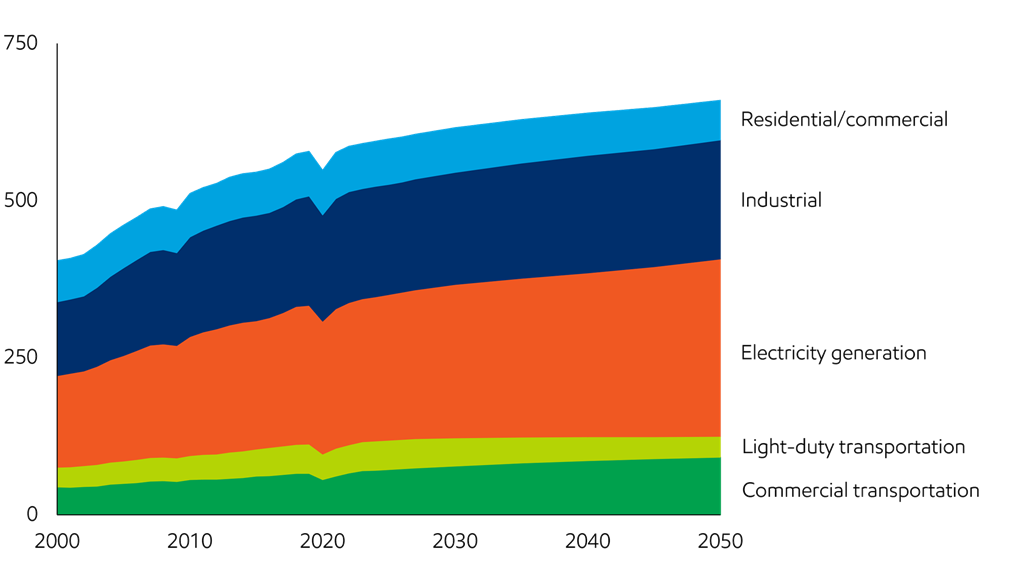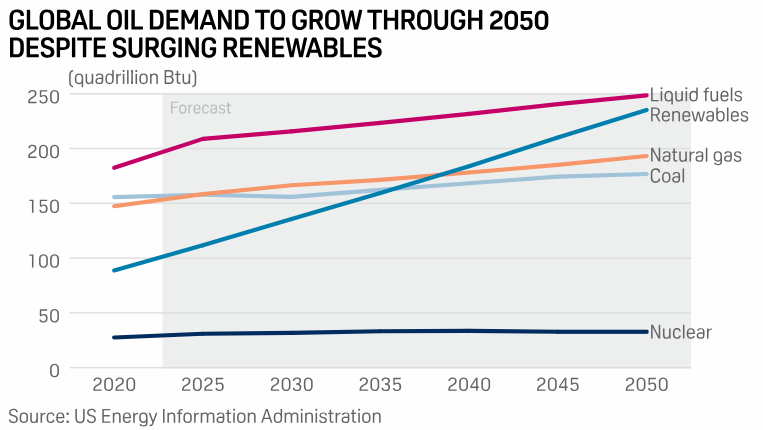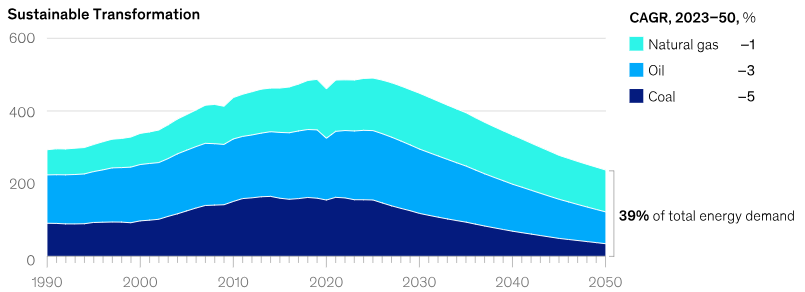
Last week's webinar "Artificial Intelligence in Municipal Governance: Opportunities and Challenges" can now be viewed HERE https://youtu.be/OYnUVz9Lsx featuring Jeff Uhlich's presentation and a follow-on general discussion. For copies of the slides contact Editor@KEInetwork.net The importance of developing a Generative AI policy is discussed HERE.
Global Energy Consumption Forecasting in the Age of Climate Change
- contributed by Yogi Schulz of CORVELLE Consulting
Energy consumption forecasting has become more complex due to economic and population growth uncertainties. While the pace of the energy transition will not determine global energy consumption, it will determine the mix of various energy sources throughout the forecast period. Forecasting how the mix of various energy sources will evolve adds more complexity to forecasting.
 Yogi Schulz has over 40 years of experience in information technology in various industries. He writes for Engineering.com, EnergyNow.ca and other trade publications. Yogi works extensively in the petroleum industry to select and implement financial, production revenue accounting, land & contracts, and geotechnical systems. He manages projects that arise from changes in business requirements, the need to leverage technology opportunities, and mergers. His specialties include IT strategy, web strategy, and systems project management.
Yogi Schulz has over 40 years of experience in information technology in various industries. He writes for Engineering.com, EnergyNow.ca and other trade publications. Yogi works extensively in the petroleum industry to select and implement financial, production revenue accounting, land & contracts, and geotechnical systems. He manages projects that arise from changes in business requirements, the need to leverage technology opportunities, and mergers. His specialties include IT strategy, web strategy, and systems project management.
Many organizations and individuals have created forecasts that vary widely and are contradictory. These forecasts are heavily influenced by my:
- Ideological commitment to or skepticism about addressing climate change.
- Views on how to conduct the energy transition technically.
- Opinion on how to finance the energy transition.
- Recognition of the role of change management in the energy transition.
In this presentation, I've been as factual as possible in discussing:
- Historic energy consumption
- Historic atmospheric GHG emissions
- Energy consumption forecasts
- Atmospheric GHG forecasts
- Conclusions about the energy transition
- Recommendations to achieve the energy transition
Most of the data and discussion is focused on the goal of the Conference of the Parties (COP), which is to hold the global average temperature increase below 1.5° C by 2050. COP is the UN organization chartered with the mandate to address climate change.
Energy consumption forecast by use. This chart shows that global consumption will reach about 660 quadrillion Btu in 2050, up about 15% versus 2021, reflecting a growing population and rising prosperity. The most significant factors in the energy consumption forecast are population growth in developing countries and the rising prosperity of that population. These two factors will overwhelm the efforts by first-world countries to reduce energy consumption and improve energy efficiency.

Source: Energy demand: Three drivers, ExxonMobil UK, 2019
The significant factors that will affect the energy consumption forecast are the growth rates for the following:
- Population
- Economic
- Electrification for:
- The energy transition
- Growth in developing countries
- Data centers for AI, cryptocurrencies, blockchain
- Commercial transportation
- Industrial consumption
Energy consumption forecast by fuel type. This chart shows increases in almost every fuel type used to create energy. It reflects the growing demand for energy across the world.

Source: Global energy demand to grow 47% by 2050, with oil still top, US EIA
I believe this forecast is quite realistic. However, it implies that the energy transition to low or no-GHG energy sources will continue well beyond 2050. You will notice that none of the fossil fuels have reached the peak of their consumption by 2050 and started on a downward trend.
Environmentalists who loudly push for a rapid energy transition to address climate change are unhappy with this chart. For example:
- They don’t like the projected increase in petroleum. They want it to decrease.
- They grudgingly accept the projected increase in natural gas but want it to level off sooner.
- They’re pleased that coal consumption is flat but want it to decrease sooner.
- They like the projected increase in renewables but want it to increase faster.
- They like the modest increase in nuclear. However, some want it to increase much faster, while others want to decrease it.
I’m surprised hydroelectric produces so little energy that it’s not even on the chart. I see an opportunity for hydroelectric to contribute more. Geothermal produces even less energy than hydroelectric. Again, I see an opportunity for geothermal to contribute more.
Global GHG Emissions Forecast. The chart below shows multiple scenarios about how the global effort to reduce GHG emissions to address climate change might play out.

Source: Net zero: What will life be like in 2050?, RBC Wealth Management
The goal of the Conference of the Parties (COP) is to hold the global average temperature increase below 1.5° C by 2050. None of the scenarios shown on the chart achieve the COP goal. Some published charts reflect achieving the COP goal. However, these are aspirational at best for the reasons discussed below.
No climate policies. If the world makes no effort to address climate change, the global average temperature will increase by 4.1–4.8° C by 2100. The temperature increase will be the same if no climate change policies are implemented. This scenario creates a forecast with a wide uncertainty range because the mix of energy fuels individual countries will employ to meet their energy consumption forecasts is challenging to predict.
Current policies. If current policies are implemented, the global average temperature will increase by 2.7–3.1° C by 2100. The forecast shows a range because some current policies are ambiguous. Also, some countries have not developed any policies.
Pledges & targets. The global average temperature will increase by 2.4° C by 2100 based on countries delivering on pledges to reduce further emissions. The pledges are contained in the press releases issued at the annual COP meetings
1.5° C pathway. GHG emissions must decrease to zero to hold the global average temperature increase below 1.5° C. Notice how this line goes below the zero line.
To reach the target of an increase in global average temperature that does not exceed 1.5 degrees Celsius, nations must go beyond Net zero and remove an additional 5 – 8 gigatons of CO2 from the atmosphere. If we accept the Energy Consumption Forecast by Fuel Type chart above as reasonably accurate, then holding the global average temperature increase below 1.5° C will not occur by 2050 and may not happen by 2100. Attempting to hold the global average temperature increase below 1.5° C with sufficiently drastic measures will cause significant public debt, consumer price increases and inflation. Some commentators suggest such an approach will lead to economic and social collapse.
Energy transition forecast. This chart shows McKinsey’s most optimistic forecast for global fossil fuel consumption in 2050 when some, including COP, want the energy transition to be complete. Complete means no or negligible fossil fuel combustion.

Source: Global Energy Perspective 2024, McKinsey
Some environmentalists promote a rapid energy transition to address climate change before it causes more ecological and property damage. Others suggest a more cautious approach given the following constraints:
- Universal resistance to change.
- Concerns about costs to businesses and households.
- Risk of adopting new energy consumption or production technology.
The uncertainties around the forecast for the pace of the energy transition include the following factors:
Uncertain progress by countries. The five countries produce over half of annual GHG emissions:
|
Rank |
Country Name |
Millions of tons of CO2 |
Percentage of World CO2 Emissions |
|
1 |
China |
12,667 |
33.0% |
|
2 |
United States |
5,057 |
12.6% |
|
3 |
India |
2,830 |
7.0% |
|
4 |
Russia |
2,032 |
5.0% |
|
5 |
Japan |
1,083 |
2.8% |
The impact of the remaining countries is negligible individually. However, other countries should not use that fact as an excuse to avoid lowering our GHG emissions where reasonably feasible. The pace at which countries are willing or able to reduce their GHG emissions varies widely. The slow current pace suggests that the energy transition will take decades beyond 2050.
Uncertain progress on reversing skepticism. The impact of GHG emissions on the climate is not easy to understand. That difficulty has created an opportunity for some to:
- Claim that climate change is natural and normal. Signification fluctuations have occurred during geological time.
- Question the science and claim there’s no consensus among scientists.
- Claim the climate is not changing, and what we’re observing is simply weather anomalies.
- Suggest we don’t need to worry. Civilization, plants and animals can adapt to the changes.
- Suggest the temperature increase of climate change is positive because it increases plant growth and agricultural yields.
- Claim that the need to address climate is a conspiracy theory.
The impact of these inaccurate arguments is to create skepticism about climate change. The public expression of this skepticism delays political action and will extend the energy transition.
Recommendations to achieve the energy transition. The pace at which governments, businesses and households act on the recommendations below will determine how long the energy transition will take beyond 2050.
Accelerate progress in reducing GHG emissions. Our challenge is to collectively reduce GHG emissions enough to have a material impact on climate change. The elements of a reasonable-cost approach that will overcome the usual resistance to change include:
- Reduce consumption of fossil fuels by replacing them with low or no-GHG-emitting energy sources gradually. Climate change denial is ridiculous.
- Implement a carbon tax that’s revenue-neutral to the government. More taxes undermine commitment.
- Quit spending money on subsidies and grants. They’re unlikely to materially accelerate the energy transition while adding enormous amounts of public debt, contributing to inflation.
- Accept that the energy transition can’t be achieved without nuclear fission power generation and include it in the mix of future energy sources.
- Focus more attention on energy conservation and efficiency. These measures are often overlooked but can contribute materially.
- Implement more electricity interconnect capacity to share renewable electricity better and increase distribution grid resilience.
- Implement a smarter electricity distribution grid to cope with more intermittent generation.
- Replace energy production and consumption devices at the end of their useful life, not sooner. Stranded assets add to cost and undermine commitment.
If governments, businesses, and households can adopt these measures more quickly, it will reduce the elapsed time needed for the energy transition beyond 2050.
Accelerate progress in development permitting. The energy transition depends on a massive increase in electricity generation, distribution, and mining of critical minerals. Most nations have added considerable complexity and uncertainties to their permitting process for major industrial and mining development projects. The motivation is often well-intentioned consultation and transparency. Accelerating slow permitting and reducing expensive delays will shorten the energy transition.
Accelerate progress in exploiting local characteristics. The mix of energy sources countries will employ to achieve the energy transition will vary enormously. For example, some nations have:
- More land and sunshine to favour solar electricity generation.
- More land and wind to favour wind electricity generation.
- Little land and will develop nuclear electricity generation.
- Little land and will pursue highly decentralized solar or wind generation.
- Geothermal resources.
- Topology suitable for hydroelectric electricity generation.
- Significant natural gas or coal resources and may choose to implement CCUS to remove the associated GHG emissions when these are burned for electricity generation.
- Access to surplus electricity from neighbours and will simply buy that.
Many countries struggle to formulate a political consensus on actioning the required additions to the energy infrastructure. Minimizing delays will shorten the energy transition.
Accelerate progress in required technology. The significant technologies required to complete the energy transition include:
- Nuclear fission electricity generation.
- Carbon Capture and Underground Storage (CCUS).
- Enhanced control technology for distribution of variable electricity generation.
- High-voltage AC or DC electricity grid interconnectors.
- Heat pumps.
- Technology to reduce energy wasted or not consumed.
- Alternative technology for cement and steel production.
- Critical minerals processing.
- Processing CO2 into commercial materials.
Sometimes, policymakers and citizens become enthralled by silver bullets that will make the energy transition faster, cheaper and easier. Examples include:
- Unfortunately, it’s an expensive and complex substitute for natural gas.
- Electric trucks. Unfortunately, the weight of the required batteries precludes them from displacing diesel.
- Nuclear fusion. Unfortunately, its development is nowhere close to commercialization.
For all required technologies, likely adopters are concerned about risk and cost. Those concerns will extend the energy transition. Government research support can reduce the time spent on development.

https://us02web.zoom.us/j/84258596166?pw..

https://us02web.zoom.us/j/84258596166?pw..

Editor@KEInetwork.net

Visit KEInetwork.net